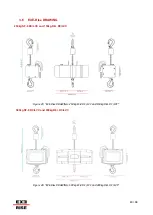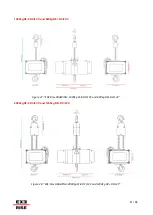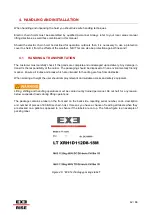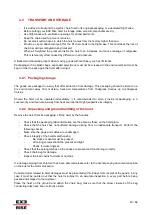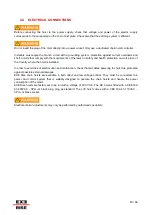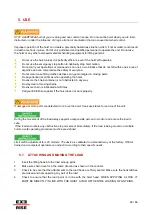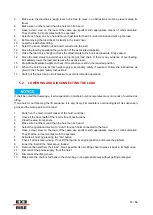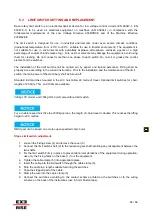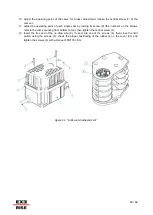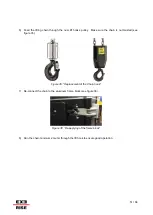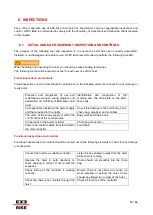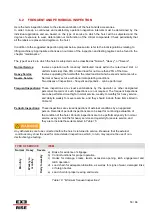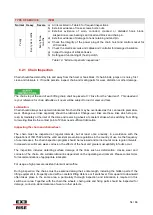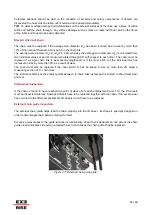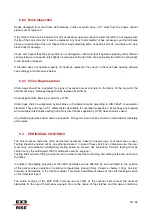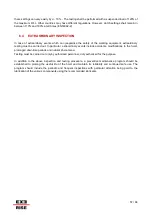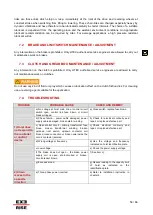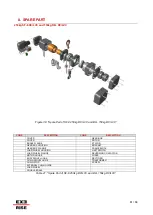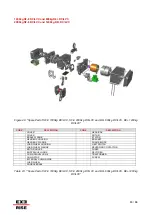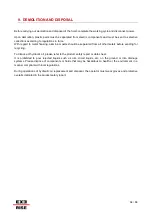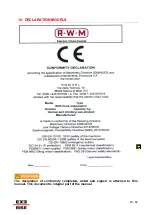
54 / 66
TYPE OF SERVICE
ITEM
Normal Heavy
Severe
a) All items listed in Table 8 for frequent inspections.
b) External evidence of loose screws, bolts, nuts.
c) External evidence of worn, corroded, cracked or distorted hook block,
suspension screw, bearings and dead end block and chain pin.
d) External evidence of damage to hook retaining nut and pin.
e) Check the integrity of the power plug of the chain hoist and control socket for
LVC models.
f) Check the electrical cords and cables and controller for damaged insulation.
g) Inspect for signs of lubricant leaks.
h) Setting and functioning of the slip clutch
Y
ea
rl
y
E
v
ery
s
ix
mo
nt
hs
E
v
ery
th
ree
mo
nt
hs
Table 19:
“Minimum periodic inspections”
6.2.1 Chain Inspection
Chain should feed smoothly into and away from the hoist or hook block. If chain binds, jumps or is noisy, first
clean and lubricate it. If trouble persists, inspect chain and mating parts for wear, distortion or other damage.
The chain stop at the end of each lifting chain shall be placed at 11 links from the “dead end”. This dead end
is your reference for chain defaults as it never will be subject to load or wear and tear.
Lubrication:
Chain should always be kept well lubricated. No chain link may be overlooked as this can lead to premature
wear. Change-over links especially should be lubricated. Change-over links are those links which stop on,
resp. immediately at the inlet of the drive and reversing wheels at constant stroke when switching from lifting
to lowering. Beside the contact point of 2 links need sufficient lubrication.
Inspecting the chain and chain wheel:
The chain must be inspected at regular intervals, but at least once annually, in accordance with the
stipulations of ISO 7592 and the valid accident prevention regulations in the country of use. As the frequency
of use increases, the chain inspection program should be reviewed and carried out at more regular intervals.
Increased use will mean wear, corrosion, the effects of the heat and greater susceptibility to faults occur.
The inspection includes detecting surface damage of the links such as deformation, cracks, wear and
corrosion. The choice of a suitable lubricant is dependent on the operating environment. Please contact Litec
for recommendations of appropriate lubricants.
For usage a high pressure resistant lubricant will suffice.
During inspection, the chains must be examined along their entire length, including the hidden parts. If the
lifting equipment is frequently used with a constant lifting distance or if switchover from upward to downward
often takes place in the same area, a particularly thorough inspection and lubrication is required in this
switch-over area. Together with the chain the wheels, chain guide and fixing parts should be inspected for
damage, corrosion, abnormal area of wear or other defects.

